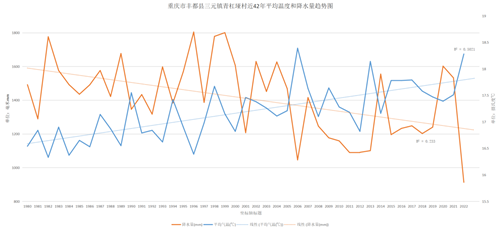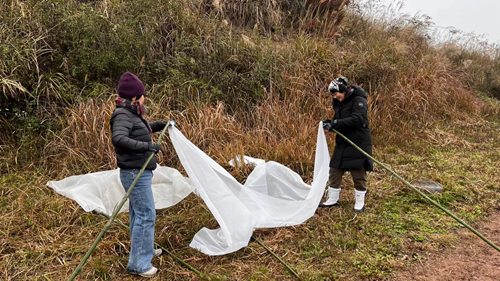Home \ Project News \ Installation of "fog nets", new explorations and pilots under the impact of climate change
Author: Publicity Assistant Yin Yueyuan
Chongqing is located in the hinterland of the Three Gorges reservoir area on the upper reaches of the Yangtze River, and is a transition zone from the Sichuan Basin to the southeastern mountainous areas, with a subtropical humid monsoon climate, rich and diverse in three-dimensional climatic resources, and characterized by frequent meteorological disasters. In terms of meteorological disasters and second-line disasters of many types, intensity, frequency, extremity, suddenness in China, Chongqing features prominent, it is an area of frequent and most serious disasters.
Since 1961, the trend of precipitation change in Chongqing has not been significant, but the number of days of heavy rainfall and the intensity of regional rainstorms have been on the increase. The number of high-temperature days and the number of vadose days have increased, the onset of heavy rainfall has advanced, and the number of low-temperature days has decreased. In particular, Qinggangya Village, located in Fengdu County, Chongqing experienced a sharp decrease in precipitation in 2022, which was the lowest in the last 42 years of history, and an increase in temperature, which was close to the highest in the 42-year history.

Based on 2023 field research conducted by HPP project staff in Qinggangya Village in September on the impacts of climate change on villagers' livelihoods, HPP began implementing the Chongqing Rural Livelihoods Climate Adaptation Project in the area.

In January 2024, with the support of Yunnan Synetics and Qianhe Community Foundation, HPP launched the Chongqing Rural Livelihoods Climate Adaptation Project in Qinggangya Village, Fengdu County, Chongqing. Through teaching villagers how to cope with the impacts of and adapt to climate change, organising trainings related to climate change adaptation, adding or optimising climate change adaptation measures, and conducting exploratory experiments on climate change adaptation, the project aims to help villagers in Qinggangya Village cope with climate change in a timely manner and adapt to the impacts of climate change. Villagers will learn how to protect themselves from extreme weather and climate change.
In order to safeguard water for local villagers' livelihoods, the project has continued to experiment and explore during implementation. We found that fog occurs throughout the year in Chongqing, the number of fog days from October to February is relatively high, and the number of fog days from March to September is relatively low. By checking the data on the website of China National Emergency Broadcasting [http://www.cneb.gov.cn/yjxx/huangsyj/], we found that in 2023, from 30 November to 7 December, Chongqing districts and counties issued 38 yellow fog warnings. At the same time, the average gust wind speed of Qinggangya Village from 1950 to 2023 can meet more than 3 meter/second.
After analysing the cases and data, the project started to install fog nets as a pilot project in Qinggangya Village where foggy weather is dense and the average wind speed reaches 3m/s. The project hopes to find a new model for mitigating the impact of climate change on agricultural livelihoods through innovative explorations.
Drawing on the case of Peru's use of dense fog to collect water, the project staff began the procurement of materials and preparation for the installation of the "fog net" on 17 January 2024, based on the characteristics of foggy conditions in Qingkangya Village. Taking into account the geographical environment and wind direction of Qingkangya Village, it was determined that the "mist-catching net" would be installed in production team 3, and the project staff worked with the village committee staff to set up small-scale experimental "mist-catching nets" as winter water catchment devices, with the dimensions of each one being 3 metres long x 1 metre high (3 square metres), and a total of four of them being installed. (3 square metres), a total of 4 "fog nets".

During this period, the project staff led the villagers to regularly observe and record the water collection capacity of the pilot device, analysed the relationship between weather conditions and water collection, and continuously improved the mist-catching network equipment and facilities, with the plan that the pilot could alleviate the production and life of the villagers under the impact of climate change.

The "Fog Net" pilot project has some results. However, in practice, because of the limitations of the weather, equipment and materials, and the experience of the project staff, the "fog net" has not been used to maximum effect.
Next, we will continue to improve the "fog net" and mitigate the impact of climate change on villagers through new explorations and pilots. At the same time, we will join hands with more climate change adaptation partners and mobilise more people to join the climate change work.
Project Description:
The Chongqing Rural Livelihoods Climate Adaptation Project is jointly supported by the Harmony Community Foundation and Yunnan Synetics partnership for Civic Organization Development. The project aims to help local villagers improve their ability to cope with climate change by teaching them how to cope with climate change impacts and adaptation methods, organising training related to climate change adaptation, adding or optimising climate change adaptation measures, and conducting exploratory experiments on climate change adaptation.
